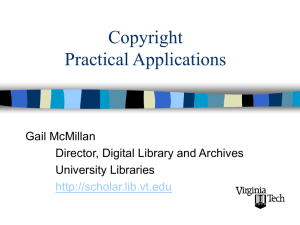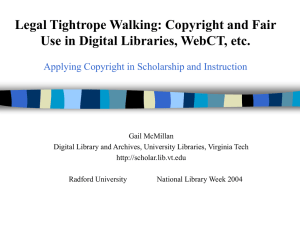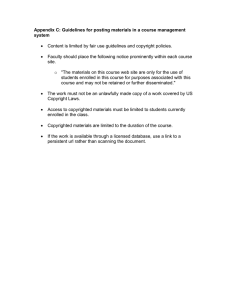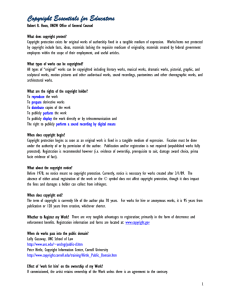Copyright Practical Applications Gail McMillan
advertisement
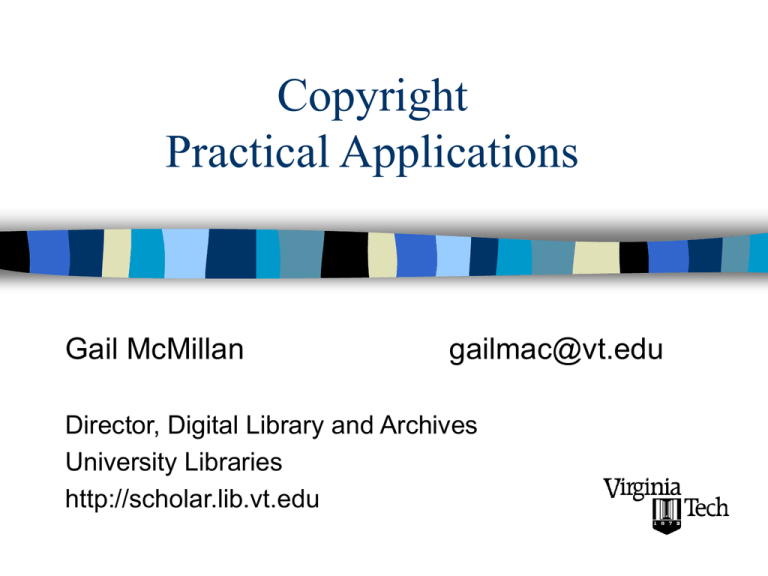
Copyright Practical Applications Gail McMillan gailmac@vt.edu Director, Digital Library and Archives University Libraries http://scholar.lib.vt.edu Who owns the copyright? Creators of original works Creators' assignees Employers: works for hire – New York Times et al., Petitioners, v. Jonathan Tasini et al. – Greenberg v. National Geographic Magazine Why officially register your copyright? – Possibly receive greater compensation, with less documentation when filing an infringement suit Rights of copyright holders 1. Reproduction 2. Modification 3. Distribution 4. Public performance 5. Public display Title 17 U.S.C. Sec. 106 Permission or license to use a copyrighted work is NOT required if Work is a fact or an idea – Phone number, earth is round Public domain – US; very, very old Fair use – http://www.utsystem.edu/OGC/IntellectualProperty/copypol2. htm#test Lolly Gassaway: http://www.unc.edu/~unclng/public-d.htm Public Domain DATE OF WORK PROTECTED FROM TERM Created 1-1-78 or after When work is fixed in tangible medium of expression Life + 70 years [1] (or if work of corporate authorship, the shorter of 95 years from publication, or 120 years from creation [2] Published before 1923 In public domainК Published from 1923 - 63 Published from 1964 - 77 Created before 1-1-78 but not published None 28 years + could be renewed for 47 years, now When published with notice extended by 20 years for a [3] total renewal of 67 years. If not so renewed, now in public domain 28 years for first term; now When published with notice automatic extension of 67 years for second term 1-1-78, the effective date of the 1976 Act which Life + 70 years or 12-31eliminated common law 2002, whichever is greater copyright 1-1-78, the effective date of Created before 1-1-78 but the 1976 Act which Life + 70 years or 12-31published between then and eliminated common law 2047 whichever is greater 12-31-2002 copyright Fair Use Before using someone else's work without permission,consider ALL 4 FACTORS 1. Purpose and character of use 2. Nature of the copyrighted work 3. Amount, substantiality 4. Effect Title 17 U.S.C. Sec. 107 1. Purpose and character of use Commercial or educational use © Myth: It's OK--it's for educational purposes. For profit or not Degree of transformation; value added –© Myth: I modified it; now it's mine. –Pretty Woman: 2 Live Crew (Campbell, aka Skywalker, et al.) v. Roy Orbison Estate (Acuff Rose Music, Inc.), 1993/94 For criticism, commentary, news reporting, teaching, scholarship, research FAIR USE 1 of 4 2. Nature of the copyrighted work Worthy of (extensive) protection? Character of the work? – fact (information) or fiction (imaginative) • Published facts weigh in favor of fair use • Unpublished original expressions weigh in favor of seeking permission FAIR USE 2 of 4 3. Amount and substantiality © Myth: Copying just a little bit is OK. Use only what is necessary – Art Quantity and quality in relation to the whole work – President Gerald Ford's memoirs: Harper & Row, Publishers, Inc. (Time) v. Nation Enterprises, 1985 http://www.publaw.com/fairuse.html FAIR USE 3 of 4 4. Effect Harm to potential market or value of a work after a portion has been used separately from the whole – © Myths • Attribution is as good as permission. • It's free advertising. original by Brad Templeton http://www.templetons.com/brad/copymyths.html FAIR USE 4 of 4 © Myths It's on the Web so I can use it without asking. It doesn't say it's copyrighted! – As of March 1, 1989, the copyright warning does not have to appear for a work to be legally copyrighted. – © 1997 by [your name] or Copyright by [your name] ALL RIGHTS RESERVED – “Permission is given to copy this work provided credit is given and copies are not intended for sale.” I have to sign away my copyright in order to get published. Copyright Resources Copyright Management Center – Kenneth Crews, IUPUI – http://www.copyright.iupui.edu/dist_learning.htm Crash Course in Copyright – Georgia Harper, University of Texas at Austin – TEACH Toolkit – http://www.loc.gov/copyright/legislation/ Library of Congress, Copyright Office – http://fairuse.stanford.edu Stay Alert to Changing Copyright Legislation – http://www.lib.ncsu.edu/scc/legislative/teachkit/guidelines.html Stanford University Library – http://www.utsystem.edu/OGC/IntellectualProperty/copypol2.htm#test http://lcweb.loc.gov/copyright/ Copyright Myths: original by Brad Templeton – http://www.templetons.com/brad/copymyths.html
